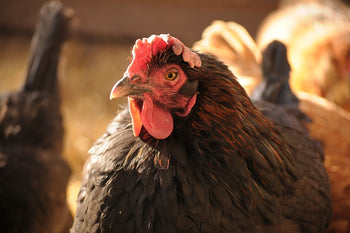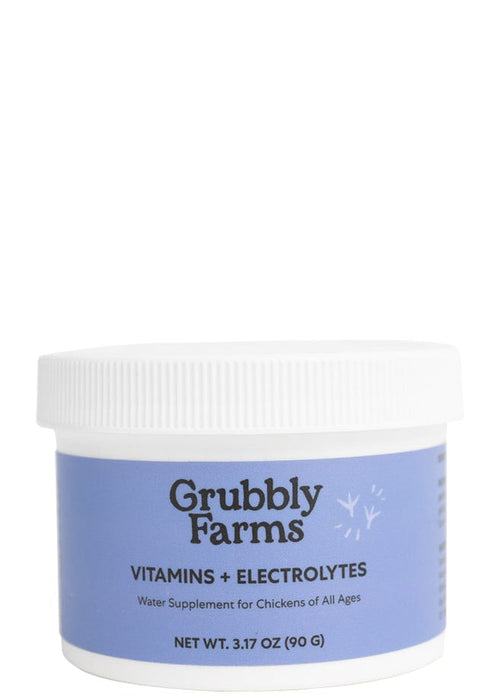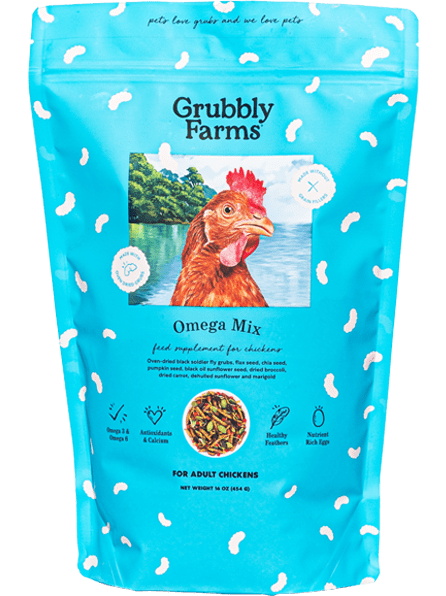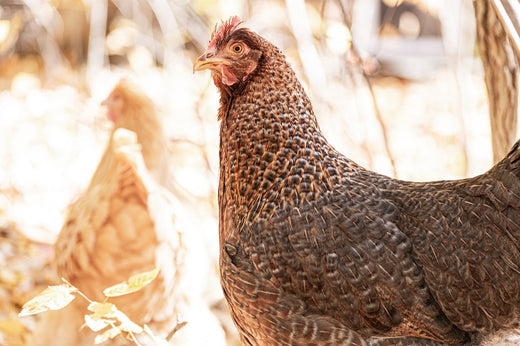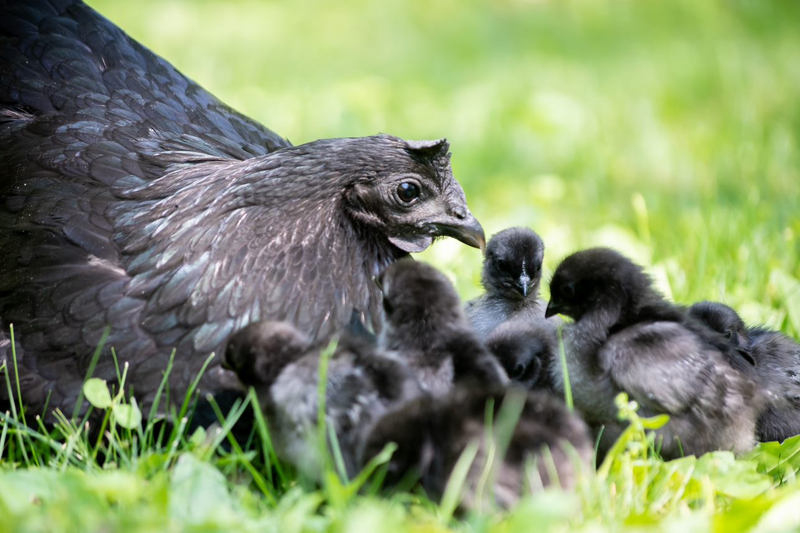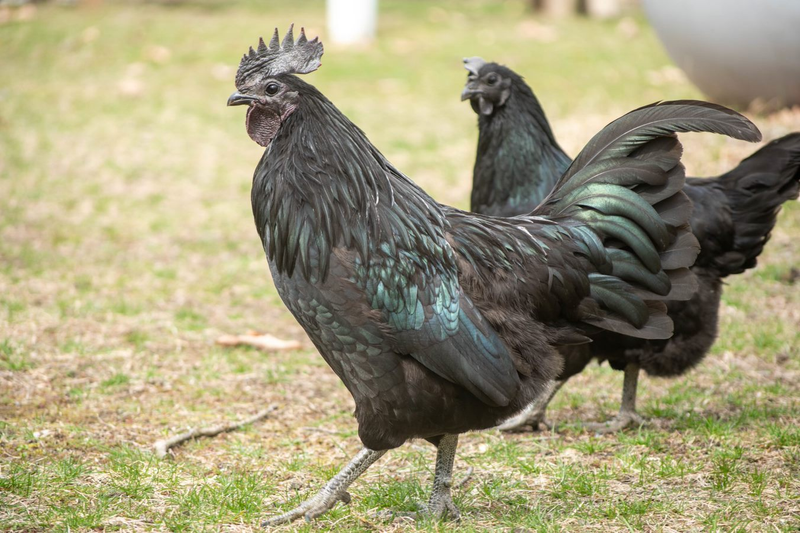Establishing a Routine Checklist
Chickens live by the survival of the fittest. Because of these instincts, sick chickens will try to hide their symptoms for as long as possible. Performing a routine health check on your flock can help identify any irregular symptoms that might get overlooked at first glance and prevent the spread of disease. It allows you to separate and treat ailing birds as soon as possible to increase their chance of recovery and prevent infections and parasites from spreading.
Regular health checks on your chickens will help you catch signs of illness, disease, injury, recurring issues, or parasites before they become serious. Performing chicken health checks is quick and easy, but you must know what you are looking for. It’s best to create a simple structure to follow so you can efficiently evaluate the health of your flock.
A routine health check should cover all the key areas of a chicken. Get familiar with how a healthy chicken should look and behave, which will help you identify unhealthy symptoms more easily. Here are the main areas you should assess:
- Combs & Wattles
- Eyes & Nostrils
- Feathers & Skin
- Legs, Feet, & Wings
- Crop
- Breathing & Respiration
- Stools
- Egg Production
- Behavior
#1. Inspecting the Exterior
Start by observing the outward health of each chicken. This includes facial features, feathers, skin, and appendages. Do a general evaluation of your entire flock first. Look for any visible differences when comparing birds within the flock. Then, catch each chicken individually and perform the following checks:
Combs and Wattles- Inspect a chicken’s comb and wattles for color, texture, swelling, shape, and abnormalities. Visually examine and feel the comb and wattles on each chicken. When healthy, they will be bright, full, and feel waxy to the touch.
The following abnormalities can indicate potential health issues:
- Purple/dark color- restricted circulation, compromised respiration
- Pale- not laying, illness, parasites
- Shriveled & dry- illness
- White spots & black scabs- fowl pox, fighting injuries
- Black tips & swollen- frostbite
When a hen is not laying, her comb will naturally be smaller and not as vibrant. This could indicate illness; however, there are several reasons why a hen might naturally take a break from laying even if she is healthy. A hen’s comb will become smaller and duller when she goes into the fall molt, when she stops laying during the winter, or when she goes broody. Pay attention to when the comb is pale, shriveled, and dry, which indicates poor health.
Eyes and Nostrils- Next, examine a chicken’s eyes and nostrils. Healthy eyes will appear bright, shiny, and alert. The nostrils should be clear and not emitting any discharge. Check for blindness by holding your pointer finger close to the eye and waiting to see if the chicken blinks as your finger gets closer. If they don’t blink and have difficulty navigating its surroundings, the chicken may be blind.
Here are some other symptoms to look for in the eyes and nostrils:
- Discharge & crusty- chronic respiratory disease
- Swelling- Marek's, chronic respiratory disease, Fowl cholera, avian influenza, infectious coryza, Newcastle
- Cloudiness in eyes- Marek's, conjunctivitis, Newcastle virus
- Watery eyes- irritation from debris, chronic respiratory disease, fowl cholera, avian influenza
- Dull & partially closed eyes- lethargy, disease
Keep in mind that chickens will occasionally cough or sneeze to clear their airways of dust or debris. An occasional cough or sneeze from a bird who otherwise appears healthy is not something to worry about. A chicken may also get watery eyes if dust, dander, or other debris gets into the area.
Feathers and Skin- Gently ruffle the feathers and run your hands down the chicken’s back to feel their texture. Part the feathers to check the chicken’s skin. The easiest places to examine the skin are the areas where no feather follicles are located, like above the vent, the armpit region under the wing, and on either side of the breastbone.
A healthy chicken should have smooth and clean feathers. Hens who have been good layers and nearing their annual fall molt may have more worn and ratty-looking feathers. Chickens who have just molted or haven’t been laying for very long will have glossy, shiny feathers.
A healthy chicken’s skin should be smooth and clean. Skin that is discolored, bluish, blood-blistered, blotchy, scabby, or scaly indicates poor health.
Also observe the skin and feathers for external parasites. The best places to look include around the vent area, under the wings, and in the feathers on the head. Look for nits, which are parasite eggs, that are clustered around the base of the feather follicles. Also keep an eye out for tiny crawling bugs on the skin, which could be mites or lice.
Here are some other things to look for in the feathers and skin:
- Pin holes in feathers- parasites
- Missing rump/back feathers- rooster treading
- Missing face/vent feathers- feather picking
- Dirty vent feathers- diarrhea, parasites
- White bumps on skin- Marek's
- Pale skin- coccidiosis, Marek’s

Legs, Wings, and Feet- Healthy chickens should have good mobility, which means their legs, feet, and wings are in good health and don’t have any abnormalities.
Chicken legs should be smooth, clean, and waxy. They naturally have scaly legs, but the scales should lie flat and feel smooth. A chicken with healthy feet will have evenly spaced, straight toes and no lumps or abnormalities between them or on the bottom of the feet. A healthy chicken will hold its wings in the proper position alongside its body, and the wing feathers should be healthy and clean.
Chickens with a wing injury may have droopy wings or feathers that are twisted and don’t lay flat. Leg injuries can be indicated by limping, hopping, or limited movement.
These are some additional symptoms to look out for in a chicken’s appendages:
- Crusty & raised leg scales- leg mites
- Crooked toes- genetics, poor hatching conditions
- Warm & swollen joints- injury, sprain, strain
- Lumps on feet- gout
- Black dot on foot pad- bumblefoot
- Limping- bumblefoot, leg injury
- Droopy wings- lethargy, broken
#2. Internal Assessment
While most injuries and some parasites are easy to spot from an external examination, many viral, bacterial, and fungal illnesses stem from internal infections. When assessing the internal health of a chicken, consider their respiration, crop health, and stool health.
Breathing and Respiration- Chickens have very sensitive respiratory systems, making them susceptible to many respiratory ailments. They can easily be irritated by dust, debris, dander, or even ammonia fumes from a poorly ventilated coop.
A chicken with healthy breathing will have quiet, even breathing. Symptoms that indicate respiratory distress include:
- Labored breathing
- Gasping
- Sneezing
- Coughing
- Wheezing
Gasping and signs of reduced circulation may hint at a blockage in the throat, which can be caused by gapeworms or a wet pox infection. Chickens will occasionally sneeze to clear their airways, but frequent sneezing combined with other symptoms can indicate illness.
Some common poultry respiratory viruses include infectious bronchitis, Marek’s disease, avian influenza, Newcastle disease, and laryngotracheitis. Common respiratory illnesses caused by bacteria include infectious coryza and chronic respiratory disease. In young chicks, brooder pneumonia is a common fungal infection characterized by respiratory distress. (1)
Crop Examination- Examining a chicken’s crop requires both an internal and external assessment. The crop is on the bird's front between the neck and breast. It is used for storing food before it is sent through the digestive system. When feeling the crop, gently massage it to see if it is full. Do not massage the crop too vigorously or in an upward motion, as that can cause the chicken to vomit.
Healthy chickens will have a crop that empties and fills daily. In the morning, you won’t be able to visually see the crop. If you feel for the crop, it will feel like a small, empty sac. By the end of the day, you may be able to visually see a bulge since the crop is full of food, and it may feel firm to the touch. By the next morning, the crop should be small again, which indicates healthy functionality.
Two common health issues you’re checking for include sour crop and impacted crop. Both conditions cause the crop to not empty properly. Sour crop occurs when food starts to ferment in the sac, making the crop feel squishy and soft. The chicken may also have sour-smelling breath. Impacted crop occurs when a blockage prevents food from emptying properly. It will feel hard and look full, even after a period of feed withdrawal.
For more information on sour crop, check out our guide, How to Prevent and Treat Sour Crop in Chickens. For more information on impacted crop, check out this guide: Crop Impaction in Chickens: Causes, Treatment, and Prevention.
Stool Evaluation- A chicken’s stool (poop) can tell you a lot about its health. Examining the color, consistency, and frequency of chicken droppings is essential for assessing the health of your flock. If there is a widespread health issue, many birds will have similar droppings. If only one bird is ailing, you may be able to single out which one based on its stool.
Install a droppings board beneath the roosts to make it easier to evaluate stools. Every morning, you can make a general assessment, and even single out birds based on where they usually roost.
There can be a wide range of ‘healthy’ stools within your flock based on seasonal factors and dietary influences. These are signs of healthy chicken poops:
- Firm, gray-brown with white caps (urates)
- Occasional sticky, light to dark brown smelly cecal droppings
- Watery droppings when water consumption increases
- Occasional pink tissue in stools (naturally shed intestinal lining)
The occasional abnormal stool or diarrhea can sometimes happen if a bird has minor digestive upset from something it ate. However, continuously abnormal stools indicate illness.
Unhealthy stools are ones that have a pasty, foamy, dry, soft/loose, watery, bloody, or slimy consistency. They may also appear to have excessive urates or be off-colored. If the stool contains worms or worm eggs, then internal parasites are the culprit. Bloody stools are also a sign of disease.
Here are some additional characteristics of unhealthy chicken stools:
- White, hard- sour crop
- Yellow/green urates- liver disease
- Bloody diarrhea- coccidiosis
- Greenish diarrhea- Marek's disease
- Dry urates- dehydration
- Diarrhea- parasites, respiratory disease, viral infections, bacterial infections

#3. Egg Production
Noticing certain patterns in egg production or certain types of eggs can clue you into the health of your flock. However, many factors can influence egg production, and not all of them are disease or illness-related.
Monitoring Egg Production- Collecting eggs from your flock every day (sometimes several times a day) is a good practice to get into, as it allows you to constantly monitor production rates. This way, you’ll be able to detect a decrease in laying activity more easily. You can also identify the hens spending time in the nesting box, which can be helpful when trying to figure out who laid an odd-shaped or abnormal egg.
Laying hens will have full, big, and bright combs and wattles. They will also have flexible and wide pubic bones, which will be stiff and narrow in hens that aren’t currently laying.
Here are some factors that will cause a decrease in egg production:
- Stress- overcrowding, boredom, predator attack, travel
- Disease/illness/injury- decrease in production & egg quality
- Improper diet- deficiencies, obesity
- Environment- severe weather, inadequate daylight
- Behaviors- broody, molting
Pay attention to the quality of eggs that your hens are laying. The occasional odd egg is nothing to stress over. Young hens who are just beginning to lay or older hens who are slowing down production may lay abnormal eggs. The occasional glitch in the reproductive system can also make a healthy hen lay a strange egg.
However, regular abnormalities or irregularities can indicate health issues, such as:
- Rough shells/calcium deposits- too much calcium
- Thin shells- osteoporosis, respiratory illness, heat stress
- Soft shells/no shells- stress, respiratory illness
- Small eggs- beginner layer, fowl cholera, infectious bronchitis
- Misshapen shell- respiratory illness

#4. Behavioral Observations
Watching how your flock behaves as a whole, as well as monitoring individual bird behaviors can give you a good assessment of flock health. Regular observations will get you familiar with the normal behaviors of a flock. Then, when something is off, you will be able to pick up on the change right away.
Normal Chicken Behavior- Chickens are flock animals and natural prey. This means they are very active, busy, and alert creatures.
Healthy chickens eat and drink regularly throughout the day. Interactions with other birds will be somewhat dictated by where the chicken is at in the flock pecking order. It’s normal for chickens to sunbathe, dust bathe, perch, and preen.
A deviation in a chicken’s normal behaviors may indicate a health issue. For example, preening is a healthy behavior chickens do each day. However, excessive preening may indicate external parasites. Chickens may also change their behaviors when they are under stress or if they are getting bullied.
When evaluating if a behavior change is health-related, watch for some of the other signs of illness that we discussed above. Here are some common behavioral changes in sick chickens:
- Lethargy
- Isolation
- Ruffled feathers
- Hunched/droopy tail/wings
- Uninterested
- Not eating or drinking
Red Flags- The range of unhealthy behaviors listed above can vary in degrees of severity. The more ill a chicken becomes, the more dramatic its behavior change will be. Whenever you notice an unhealthy change in behavior or notice symptoms of illness, quarantine the chicken as soon as possible. This can help you monitor the bird more closely and gives you a chance to specifically assess its stools and behaviors.
Some behaviors can come on suddenly and warrant immediate attention, including:
- Not eating or drinking
- Hiding/seeking seclusion with lethargy and hunched posture
- Reluctance to move
Once in quarantine, further monitor the bird for emaciation, unhealthy stools, and any other symptoms that can help you diagnose the ailment. Consult an avian expert or veterinarian for guidance on diagnosing or treating the sick chicken.
Abnormal behaviors are often a result of viral infections, bacterial infections, fungal infections, or parasites. Many of these infections can be further narrowed down and officially diagnosed by a veterinarian.

Conclusion
Performing routine health checks is essential for monitoring the health of your flock. Knowing what to look for internally, externally, with egg production, and their behavior helps you catch any health issues before they become serious or spread through your entire flock. The sooner you can catch an ailment, the better chance the chicken has of recovering and containing the illness. In conclusion, implement a monthly chicken health check as part of your backyard flock biosecurity protocols!
- Damerow, Gail. The Chicken Health Handbook: A Complete Guide to Maximizing Flock Health & Dealing with Disease. Storey Publishing, 2015





